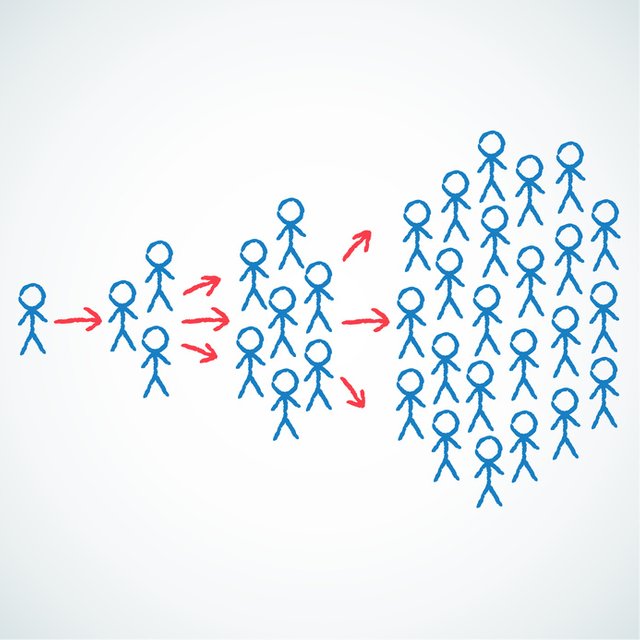Viral Marketing, Viral Loops and the Viral Coefficient
How To Get Exponential Growth on Autopilot

Viral marketing is the process of getting your users to refer others in such a way that growth becomes automatic; no further external efforts are required. Just think of how a Youtube video spreads like a virus around the globe and imagine a similar process for how users might be able to spread a product the same way through word-of-mouth. The first part of the process is having a product that people want to recommend organically. Good products solve problems and people naturally want to share them. Viral marketing is all about taking a good product and making it easier to spread and also creating extra incentives to do so.
One of the early examples of viral marketing is the story of Hotmail in the early Internet days as explained in Eric Reis's book the Lean Startup. In 1996, Sabeer Bhatia and Jack Smith bootstrapped their free email service with a small seed round and couldn't afford a huge marketing campaign so they stagnated for some time. However, they made one small change by adding “PS get your free e-mail at Hotmail” at the end of everyone's email messages with a link. In six months they had 1 million users, in 18 months they had 12 million and subsequently sold the company to Microsoft for $400 million!
Much of the following information & insights below are sourced from the book Traction, by Weinberg & Mares:
Viral Loops

A viral loop is a three-step process:
- customer uses your product/service
- customer tells others about your product/service
- a portion of those that hear about the product/service from the original customer become customers themselves.
As you can see the new customers can in turn tell others about your product/service and create an ongoing loop.
There are various types of viral loops. Some products like Skype or Whatsapp are inherently viral because people invite their friends to make the product more useful to them. Google Docs enhance collaboration of groups so there may be spurts of user growth when teams get together for the first time. Like Hotmail, Apple appends 'Sent from iPhone' on messages. Weebly Mailchimp, Desk.com all brand their free email service. Other companies give incentives for referrals. Dropbox gives storage space. Paypal gave away money. Gilt, AirBnb, and Uber give account credits. Reddit and Youtube have embed buttons and widgets. Facebook and Twitter are on most websites for sharing. Other companies depend on these social networks to gain viral traction. Pinterest leveraged Facebook and Twitter early on to allow people to easily invite their friends and followers. If you look at LinkedIn they have a button you can press to allow them to search all your email accounts for contacts to invite!
The Viral Coefficient

The formula to measure virality is:
K = I * R
K is the viral coefficient, I the # of invites, and R is the conversion rate.
For example if each person invites 5 people and the conversion rate is 50% the viral coeffient is 2.5, an incredible number (K = 5 * 50% = 2.5). If each person invites 1 and the conversion rate is 10% the viral coefficent is .1 and viral growth is not sustainable (K = 1 * 10% = 0.1). Any viral coefficient above 1 will result in exponential growth. You can increase the # of invites a person makes by making the invite process easier or adding other social platforms to invite from. To increase conversion, you can improve invitation click-thru & signup rates as well as the general signup process. Finally the viral cycle time is important because shorter cycle times can improve growth dramatically.
Conclusion
Viral marketing is a process. Make sure you have a good product and integrate the appropriate viral component as part of the overall product design. Use the viral coefficient formula to test and measure each step in the viral loop.
Here are some tactical tips:
- Run A/B tests on the entire viral loop flow (ie. from invites, to click-thrus to sign-ups)
- Focus on one area first.
- Cut out unnecessary steps
- Make invites short and succinct.
- Copy the process of bigger companies
- Test the details; one word can make a big impact
- Seed viral loops with other outreach campaigns if loop is not sustaining itself.
- Shorten viral cycle times
- Look for viral pockets in a subgroup of customers
- Test, test and test some more.
Now let's go

Wow :-O - such a long story with lots of upvotes and no comments :-)
To go viral whales should support creative steemians or at least stop downvoting them, eg like happened to Jiggly Steem Ad
Let the small fishes decide what they like :-)
Check this blog of mine on similar subject. I have tried to bring out what roles emotions play in marketing !!